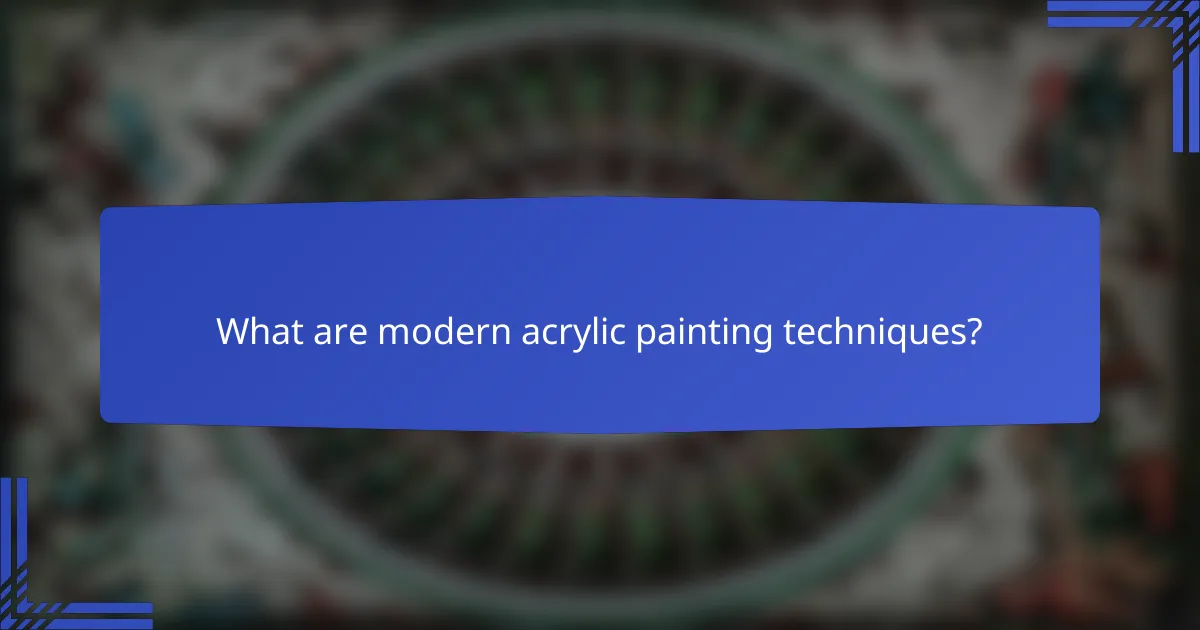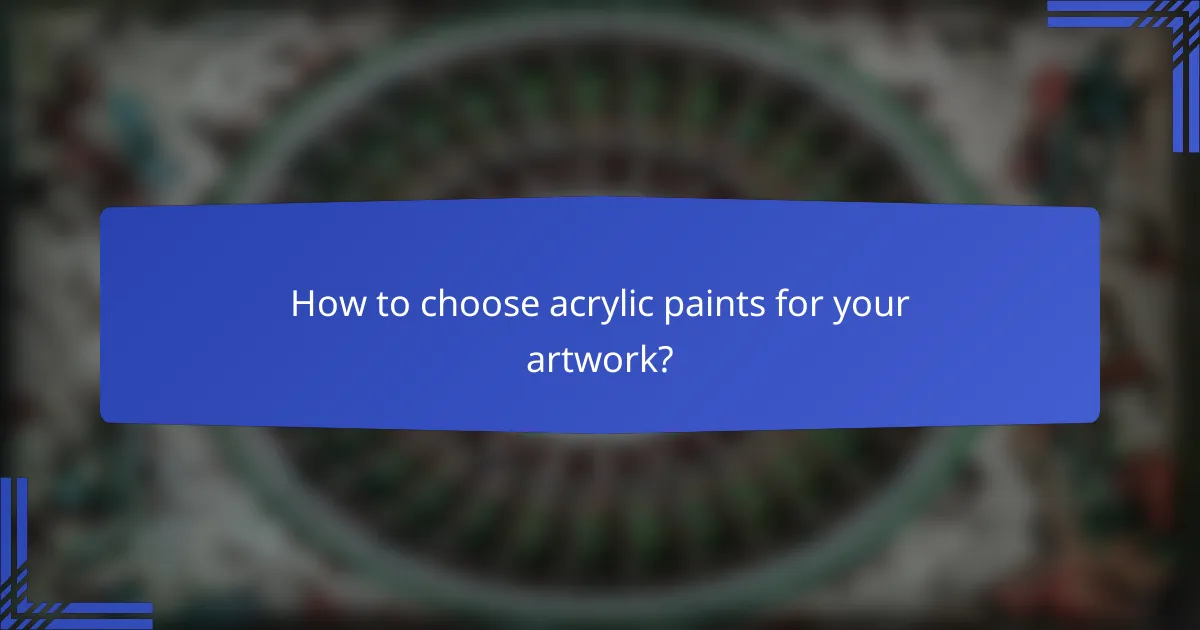Acrylic painting has evolved into a dynamic medium, with modern techniques that enhance its versatility and vibrancy. Artists utilize innovative methods to create unique textures and effects, resulting in captivating works of art. Popular acrylic artists continue to push boundaries, contributing significantly to contemporary art, while notable exhibitions showcase the diverse styles and talents within this vibrant community.

What are modern acrylic painting techniques?
Modern acrylic painting techniques encompass a variety of methods that enhance the versatility and vibrancy of acrylic paints. These techniques allow artists to create unique textures, layers, and effects that can transform a simple canvas into a dynamic work of art.
Pouring techniques
Pouring techniques involve mixing acrylic paint with a pouring medium to create a fluid consistency that can be poured onto a canvas. This method allows for the creation of abstract designs with smooth transitions and unpredictable patterns. Artists often use silicone oil to create cells and interesting textures within the poured paint.
When using pouring techniques, it’s essential to work quickly before the paint dries. A common approach is to layer different colors in a cup and then pour them onto the canvas, allowing them to flow and blend naturally. Experimenting with different pouring mediums can yield various results, so consider testing a few to find the best fit for your style.
Layering methods
Layering methods involve applying multiple coats of acrylic paint to build depth and richness in a painting. This technique allows artists to create complex images by gradually adding colors and details. Each layer can be transparent or opaque, depending on the desired effect.
To effectively layer acrylics, start with a base layer and allow it to dry completely before adding subsequent layers. Use a variety of brushes and tools to create different textures and effects. Remember to thin your paint with water or a medium for smoother application between layers.
Mixed media applications
Mixed media applications combine acrylic paints with other materials such as collage elements, pastels, or inks to create multidimensional artworks. This technique allows for greater creativity and experimentation, as artists can incorporate various textures and visual elements into their pieces.
When working with mixed media, consider how different materials interact with acrylics. For instance, using paper or fabric can add interesting layers, while incorporating inks can provide vibrant contrasts. Always ensure that your chosen materials are compatible with acrylics to avoid issues with adhesion or drying.
Brush techniques
Brush techniques in acrylic painting involve using different types of brushes to achieve various effects, such as fine lines, broad strokes, or textured patterns. Artists can manipulate the paint’s consistency and application method to create unique visual outcomes.
Experiment with different brush shapes, such as flat, round, or fan brushes, to discover how they affect your painting style. Dry brushing can create a textured look, while wet-on-wet techniques allow for smooth blending. Always clean your brushes thoroughly between colors to maintain clarity and prevent muddying your palette.
Palette knife techniques
Palette knife techniques utilize a flat, blunt tool to apply and manipulate acrylic paint on the canvas. This method is excellent for creating thick textures and bold strokes, allowing for a more expressive style. Palette knives can also be used to scrape away paint for interesting effects.
When using a palette knife, load it with paint and apply it directly to the canvas, experimenting with different angles and pressures to achieve desired textures. This technique is particularly effective for landscapes and abstract works, where texture plays a significant role in the overall composition.

Who are the most popular acrylic artists?
The most popular acrylic artists are known for their innovative use of acrylic paint, which allows for vibrant colors and diverse techniques. These artists have made significant contributions to contemporary art, each bringing their unique style and perspective to the medium.
Mark Rothko
Mark Rothko is renowned for his color field paintings, which often feature large blocks of color that evoke emotional responses. His use of acrylics allowed him to achieve a luminous quality in his works, enhancing the depth and intensity of the colors.
Rothko’s approach emphasizes simplicity and abstraction, encouraging viewers to engage with the emotional landscape of his art. His iconic pieces, such as those in the Rothko Chapel, showcase the power of color in conveying profound feelings.
David Hockney
David Hockney is celebrated for his vibrant landscapes and portraits, often utilizing acrylics to create bold, colorful compositions. His innovative techniques, including the use of digital tools, have expanded the possibilities of acrylic painting.
Hockney’s works often reflect his fascination with light and perspective, as seen in his famous pool scenes and depictions of California. His playful use of color and form invites viewers to experience the world through his unique lens.
Yayoi Kusama
Yayoi Kusama is known for her immersive installations and polka dot motifs, often employing acrylics to create striking visual experiences. Her art explores themes of infinity and self-obliteration, using repetitive patterns and vibrant colors to engage the viewer.
Kusama’s work, such as her Infinity Mirror Rooms, transforms spaces into captivating environments that challenge perceptions of reality. Her distinctive style has made her a leading figure in contemporary art, appealing to a wide audience.
Gerhard Richter
Gerhard Richter is a versatile artist whose acrylic works range from abstract to photorealistic. He often experiments with layering and blending techniques, creating dynamic surfaces that invite viewers to explore the interplay of color and form.
Richter’s approach to acrylic painting includes the use of squeegees and brushes, resulting in textured, complex compositions. His ability to shift between styles keeps his work fresh and relevant in the contemporary art scene.

What are notable acrylic art exhibitions?
Notable acrylic art exhibitions showcase contemporary works that highlight the versatility and vibrancy of acrylic paint. These events often feature a diverse range of artists and styles, making them key destinations for art enthusiasts and collectors alike.
Art Basel Miami Beach
Art Basel Miami Beach is one of the premier art fairs in the world, attracting galleries and artists from across the globe. The event features a substantial number of acrylic artworks, emphasizing modern techniques and innovative approaches to this medium.
Visitors can expect to see a mix of established and emerging artists, with many works pushing the boundaries of acrylic painting. The fair also includes panel discussions and events that delve into current trends in acrylic art.
The Armory Show
The Armory Show in New York City is another significant exhibition that highlights contemporary art, including acrylic pieces. This event focuses on modern and contemporary works, providing a platform for both renowned and up-and-coming artists.
Attendees can explore a variety of acrylic techniques, from traditional methods to experimental applications. The Armory Show often features curated sections that spotlight specific themes or movements within the acrylic medium.
Frieze Art Fair
Frieze Art Fair, held in London and other locations, is known for its cutting-edge approach to contemporary art, including acrylic works. The fair showcases a diverse range of galleries, each presenting unique interpretations of acrylic painting.
Frieze emphasizes the importance of innovation in art, making it a prime venue for discovering new acrylic techniques and styles. The fair also hosts talks and events that engage with current artistic practices, offering insights into the evolving landscape of acrylic art.

How to choose acrylic paints for your artwork?
Choosing acrylic paints involves considering factors like viscosity, color quality, and brand reputation. These elements significantly impact your painting experience and the final result of your artwork.
Understanding paint viscosity
Viscosity refers to the thickness of the paint, which affects how it flows and adheres to surfaces. Acrylic paints typically range from fluid to heavy body, allowing for various techniques such as glazing or impasto. For detailed work, a fluid paint may be preferable, while a heavy body paint is ideal for textured applications.
When selecting acrylics, consider how viscosity aligns with your intended technique. Test different viscosities to see how they behave on your chosen substrate, as this can influence the overall look of your artwork.
Evaluating color quality
Color quality in acrylic paints is determined by the pigment concentration and lightfastness. High-quality paints often have a higher pigment load, resulting in vibrant colors that maintain their integrity over time. Look for paints labeled as professional or artist-grade for the best color performance.
To assess color quality, check for ratings on lightfastness, which indicates how well the paint resists fading when exposed to light. A scale of I to III is commonly used, with I being the most lightfast. This is crucial for artworks intended for display.
Considering brand reputation
Brand reputation plays a significant role in the quality and consistency of acrylic paints. Established brands often have a history of producing reliable products, which can save you time and frustration. Research reviews and artist testimonials to gauge the performance of different brands.
When trying a new brand, consider purchasing small tubes or sets to test their paints without a large investment. This allows you to evaluate their viscosity, color quality, and overall handling before committing to larger quantities.

What are the benefits of using acrylics?
Acrylics offer numerous advantages for artists, including quick drying times, versatility, and vibrant colors. They can be used on various surfaces and are water-soluble when wet, making them easy to clean up and manipulate.
Modern techniques in acrylic painting
Modern techniques in acrylic painting include layering, glazing, and pouring. Artists often use layering to build depth and texture, while glazing allows for transparency and luminosity by applying thin, transparent layers of paint.
Pouring techniques involve mixing acrylics with a pouring medium to create fluid art. This method produces unique patterns and effects, appealing to both abstract and representational artists.
Popular acrylic artists today
Some notable contemporary acrylic artists include Mark Rothko, known for his color field paintings, and Julie Mehretu, who combines abstraction with mapping and architecture. Their innovative approaches showcase the versatility of acrylics in modern art.
Emerging artists like Kelsey Montague and Yellena James are also gaining recognition for their vibrant and intricate acrylic works, often incorporating elements of street art and nature.
Exhibition highlights featuring acrylic art
Exhibitions showcasing acrylic art often emphasize the medium’s adaptability and range. Events like the annual “Acrylics Only” show in major cities feature works from both established and emerging artists, highlighting new techniques and themes.
Art fairs such as Art Basel frequently include acrylic pieces, reflecting current trends and innovations in the medium. Visitors can explore diverse styles, from abstract to hyper-realistic, demonstrating the broad appeal of acrylics in contemporary art.
